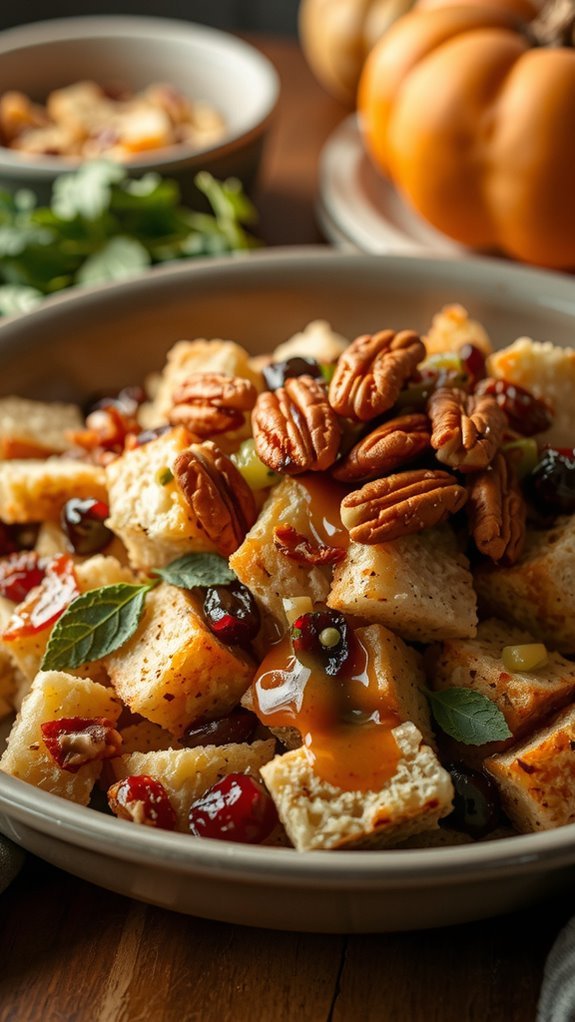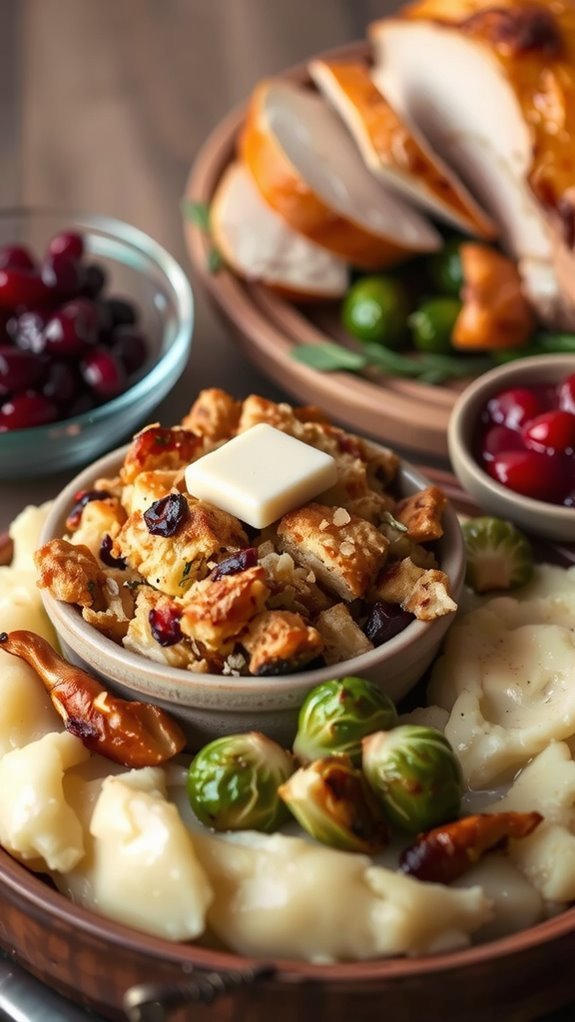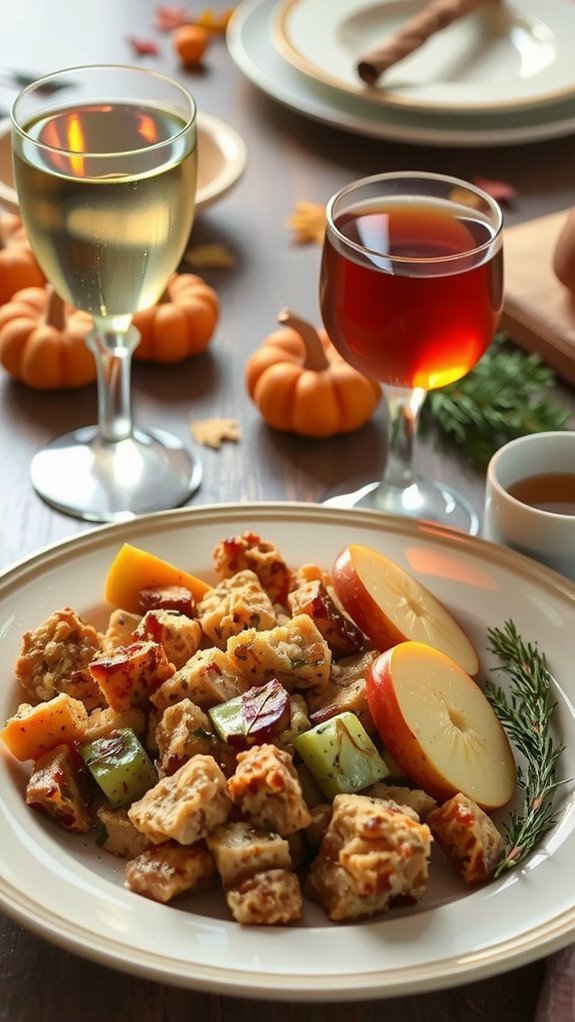As an Amazon Associate I earn from qualifying purchases.
Editorial Policy | Disclosure Policy
What kind of recipe is it?
Make-Ahead Thanksgiving Stuffing is a flavorful and convenient dish perfect for those looking to simplify their holiday preparations.
This stuffing combines a medley of bread, herbs, and vegetables, creating a savory side that complements any turkey.
Its unique feature is the ability to prepare it in advance, allowing for stress-free cooking on Thanksgiving day.
Ideal for busy families or hosts wanting to impress guests, it offers rich flavors and ease, making it a must-have for any festive gathering.
Ingredients
| Ingredient | Quantity |
|---|---|
| Bread | 1 loaf (about 12-14 cups cubed) |
| Onion | 1 large, diced |
| Celery | 2-3 stalks, diced |
| Garlic | 2-3 cloves, minced |
| Unsalted butter | 1/2 cup (1 stick) |
| Chicken or vegetable broth | 2-3 cups |
| Fresh parsley | 1/4 cup, chopped |
| Fresh sage | 2 tablespoons, chopped |
| Fresh thyme | 1 tablespoon, chopped |
| Dried rosemary | 1 teaspoon |
| Salt | 1 teaspoon (or to taste) |
| Black pepper | 1/2 teaspoon (or to taste) |
| Eggs | 2 large |
| Optional add-ins (like sausage or nuts) | 1 cup (optional) |
This table summarizes the essential ingredients and their respective quantities for creating a delicious Make-Ahead Thanksgiving Stuffing. Adjust the quantities based on the number of servings desired or personal taste preferences.
Cooking Steps
1. Preheat the oven to 176 °C (350 °F) and position the oven rack to the center. Line a 23 x 33 cm (9 x 13 inch) baking dish with parchment paper or grease it with cooking spray.
2. In a large skillet (preferably non-stick), melt 1/2 cup (1 stick) of unsalted butter over medium heat. Stir occasionally until melted and foamy, about 2-3 minutes.
3. Add 1 large diced onion and 2-3 diced celery stalks to the skillet. Sauté, stirring frequently, until the vegetables are softened and translucent, about 5-7 minutes. The aroma should be fragrant and the onions should appear glassy.
4. Stir in 2-3 minced garlic cloves and continue to sauté for an additional 1-2 minutes until the garlic is fragrant but not browned.
5. Remove the skillet from heat and transfer the sautéed mixture to a large mixing bowl. Add 12-14 cups of cubed bread, 1/4 cup of chopped fresh parsley, 2 tablespoons chopped fresh sage, 1 tablespoon chopped fresh thyme, and 1 teaspoon of dried rosemary.
Mix thoroughly until the bread is well coated.
6. Gradually pour in 2-3 cups of chicken or vegetable broth, mixing until all the ingredients are evenly moistened. The bread should be soaked but not overly soggy.
7. In a separate bowl, whisk together 2 large eggs, 1 teaspoon of salt, and 1/2 teaspoon of black pepper.
Pour this mixture into the stuffing and combine until evenly incorporated.
8. If using optional add-ins (like sausage or nuts, 1 cup), fold them in at this stage until evenly distributed.
9. Transfer the stuffing mixture into the prepared baking dish, and lightly press it down to guarantee an even layer.
Cover the dish with aluminum foil.
10. Bake in the preheated oven for 25 minutes, then remove the foil and bake for an additional 15-20 minutes until the top is golden brown and crispy.
The internal temperature should reach at least 74 °C (165 °F) when measured with a food thermometer.
11. Once cooked, remove the stuffing from the oven and let it rest at room temperature for at least 10 minutes before serving.
This allows the flavors to meld and the texture to firm up.
12. Serve the stuffing warm, and enjoy the aroma of herbs and buttery bread as it enhances your Thanksgiving feast.
Variations
- Herb and Chestnut Stuffing: Replace parsley and fresh herbs with 1 cup (200 g) cooked and chopped chestnuts and include 1 tablespoon (15 ml) of herbes de Provence for a nutty, aromatic flavor.
- Sausage and Sage Stuffing: Incorporate 450 g (1 lb) of cooked and crumbled sausage into the bread mixture for a hearty, savory twist.
- Vegan Mushroom Stuffing: Substitute butter with 120 ml (1/2 cup) olive oil, use vegetable broth instead of chicken broth, and omit the eggs for a rich, plant-based version; add 300 g (10 oz) of diced mushrooms for an umami boost.
- Gluten-Free Stuffing: Use gluten-free bread (12-14 cups/300-350 g) in place of regular bread and guarantee all other ingredients are certified gluten-free to accommodate dietary restrictions.
Tips on plating and presentation

When serving your stuffing, presentation plays a significant role in elevating the dish.
I love using a decorative dish that complements my table setting. Scoop the stuffing gently, allowing it to hold its shape, and garnish with fresh herbs or nuts for a pop of color.
A drizzle of gravy can also enhance visual appeal while inviting guests to dig in!
What other dishes can I pair it with?

While planning my Thanksgiving meal, I often consider what dishes pair well with my make-ahead stuffing. Roasted turkey is a classic choice, enhancing the savory flavors.
I love serving it alongside creamy mashed potatoes and rich gravy for a comforting touch. Green beans or Brussels sprouts add a nice crunch, while cranberry sauce provides a tangy contrast to balance everything beautifully.
What drinks can I pair it with?

To elevate your Thanksgiving meal, consider pairing my make-ahead stuffing with the perfect drinks. A crisp, chilled Sauvignon Blanc complements savory flavors beautifully.
If you’re looking for something heartier, a light-bodied Pinot Noir works wonders.
For non-alcoholic options, a spiced apple cider or herbal tea brings warmth and a festive touch.
These pairings will surely impress your guests and enhance your holiday spread!
Frequently Asked Questions
Can I Freeze the Stuffing Before Cooking?
Yes, you can freeze the stuffing before cooking. I often prepare mine in advance, then place it in an airtight container. When you’re ready, just thaw it and bake as usual. It works perfectly!
How Long Can I Store Uncooked Stuffing in the Refrigerator?
I usually store uncooked stuffing in the refrigerator for up to two days. After that, I find it’s best to freeze it to maintain freshness and avoid potential spoilage. Enjoy your cooking!
Is This Stuffing Safe to Reheat Leftovers?
Yes, I find it’s safe to reheat leftover stuffing as long as it’s stored properly in the refrigerator. Just make sure to heat it thoroughly, and it’ll taste delicious again!
What Type of Bread Works Best for Stuffing?
I find that a sturdy bread like sourdough or French bread works best for stuffing. They absorb flavors beautifully without turning mushy. It’s all about achieving that perfect balance of texture and taste.
Can I Make This Stuffing Gluten-Free?
I’ve tried using gluten-free bread in my stuffing, and it turned out great. Just make sure it’s sturdy enough to hold up the moisture, and you’ve got yourself a delicious gluten-free option everyone can enjoy!
